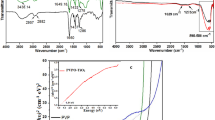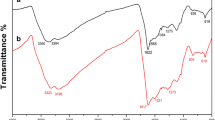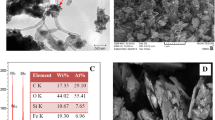Abstract
An amperometric non-enzymatic glucose sensing based on polyvinylpyrrolidone and titanium dioxide nanocomposites (PVP–TiO2 NCs) fabricated over stainless-steel (SS) electrode was experimented. The electrode was fabricated of PVP–TiO2 NCs onto SS surface through drop casting coating. The NCs and the electrode were analyzed using Fourier transform infrared (FTIR) and UV–visible (UV–Vis) spectroscopy, X-ray diffraction spectra (XRD), X-ray photoelectron spectra (XPS), particle analyzer, scanning electron microscopy (SEM), EDS and transmission electron microscopy (TEM) and Brunauer–Emmett–Teller (BET) analysis for surface. For electrochemical investigation, cyclic voltammetry, electrochemical impedance spectra, including Nyquist plots and Bode plots, and chronoamperometry were adopted. PVP-TiO2/SS-modified electrode manifested high sensitivity of 360.13 µA/mM.cm2, lower detection limit of 756.8 µM and 0 to 13 mM linear range with regression coefficient of R2 = 0.992. The electrode exhibited high stability with good anti-interference tendency against fructose, uric acid, ascorbic acid and sucrose. The modified electrode also performed well in real sample glucose detection. Further, PVP–TiO2 NCs performed appreciably toward antibacterial studies against some Gram-positive and Gram-negative deleterious bacteria, Escherichia coli, Klebsiella pneumoniae, Staphylococcus aureus, Shigella flexneri microbes.















Similar content being viewed by others
Data availability
Supplementary data and material will be published as received from the author.
References
Abdi MM, Mohd Azli NFW, Lim HN et al (2018) Polypyrrole/tannin biobased nanocomposite with enhanced electrochemical and physical properties. RSC Adv 8:2978–2985. https://doi.org/10.1039/c7ra13378b
Ahmad R, Vaseem M, Tripathy N, Hahn YB (2013) Wide linear-range detecting nonenzymatic glucose biosensor based on CuO nanoparticles inkjet-printed on electrodes. Anal Chem 85:10448–10454. https://doi.org/10.1021/ac402925r
Akrema R (2018) Metal Nanoparticles as Glucose Sensor. 143–168. https://doi.org/10.1007/978-981-10-6214-8_5
Al-mokaram AMAAA, Yahya R, Abdi MM, et al The Development of Non-Enzymatic Glucose Biosensors Based on Electrochemically Prepared Polypyrrole – Chitosan – Titanium Dioxide Nanocomposite Films. https://doi.org/10.3390/nano7060129
Arul Hency Sheela J, Lakshmanan S, Manikandan A, Arul Antony S (2018) Preparation and Characterizations of PVP–TiO2 NPs Calcined at 500, 600 and 700 °C by the Hydrothermal Method and Their Properties. J Inorg Organomet Polym Mater 28:2036–2045. https://doi.org/10.1007/s10904-018-0872-1
Arun Kumar D, Merline Shyla J, Xavier FP (2012) Synthesis and characterization of TiO2/SiO2 nano composites for solar cell applications. Appl Nanosci (switzerland) 2:429–436. https://doi.org/10.1007/s13204-012-0060-5
Ashfaq A, Ikram M, Haider A, et al (2021) Nitrogen and Carbon Nitride-Doped TiO2 for Multiple Catalysis and Its Antimicrobial Activity. Nanoscale Res Lett 16.https://doi.org/10.1186/s11671-021-03573-4
Baby TT, Ramaprabhu S (2010) SiO2 coated Fe3O4 magnetic nanoparticle dispersed multiwalled carbon nanotubes based amperometric glucose biosensor. Talanta 80:2016–2022. https://doi.org/10.1016/j.talanta.2009.11.010
Bharti B, Li H, Liu D, et al (2020) Efficient Zr-doped FS–TiO2/SiO2 photocatalyst and its performance in acrylonitrile removal under simulated sunlight. Appl Phys A Mater Sci Process 126.https://doi.org/10.1007/s00339-020-04066-4
Bilal S, Ullah W, Shah AA (2018) Polyaniline@CuNi nanocomposite: A highly selective, stable and efficient electrode material for binder free non-enzymatic glucose sensor. Electrochim Acta. https://doi.org/10.1016/j.electacta.2018.07.165
Bolla AS, Priefer R (2020) Blood glucose monitoring- an overview of current and future non-invasive devices. Diabetes Metab Syndr 14:739–751. https://doi.org/10.1016/j.dsx.2020.05.016
Bruen D, Delaney C, Florea L, Diamond D (2017) Glucose sensing for diabetes monitoring: Recent developments. Sensors (switzerland) 17:1–21. https://doi.org/10.3390/s17081866
De Faria RAD, Iden H, Dias Heneine LG, et al (2019) Non-enzymatic impedimetric sensor based on 3-aminophenylboronic acid functionalized screen-printed carbon electrode for highly sensitive glucose detection. Sensors (Switzerland) 19.https://doi.org/10.3390/s19071686
De Urquijo-Ventura MS, Rao MGS, Meraz-Davila S, et al (2020) PVP-SiO2 and PVP-TiO2 hybrid films for dielectric gate applications in CdS-based thin film transistors. Polymer (Guildf) 191.https://doi.org/10.1016/j.polymer.2020.122261
Dewan A, Haldar S, Narayanan R (2021) Multi-shelled NiO hollow microspheres as bifunctional materials for electrochromic smart window and non-enzymatic glucose sensor. 821–830
Dhanda M, Nehra SP, Lata S (2022) The amalgamation of g-C3N4 and VO2 (D) as a facile electrode for enhanced storage of energy. Synth Met 286:117046. https://doi.org/10.1016/j.synthmet.2022.117046
Dhara K, Mahapatra DR (2018) Electrochemical nonenzymatic sensing of glucose using advanced nanomaterials. Microchim Acta. https://doi.org/10.1007/s00604-017-2609-1
Dhatarwal P, Sengwa RJ (2021) Poly(vinyl pyrrolidone) matrix and SiO2, Al2O3, SnO2, ZnO, and TiO2 nanofillers comprise biodegradable nanocomposites of controllable optical properties for optoelectronic applications. Optik 241:167215. https://doi.org/10.1016/j.ijleo.2021.167215
Di Valentin C, Finazzi E, Pacchioni G et al (2007) N-doped TiO2: Theory and experiment. Chem Phys 339:44–56. https://doi.org/10.1016/j.chemphys.2007.07.020
Dong H, Kyung S, Chang H et al (2012) Biosensors and Bioelectronics A glucose biosensor based on TiO2–Graphene composite. Biosensors and Bioelectronic 38:184–188. https://doi.org/10.1016/j.bios.2012.05.033
Emir G, Dilgin Y, Ramanaviciene A, Ramanavicius A (2021) Amperometric nonenzymatic glucose biosensor based on graphite rod electrode modified by Ni-nanoparticle/polypyrrole composite. Microchem J 161.https://doi.org/10.1016/j.microc.2020.105751
Fatema KN, Zhu L, Cho KY et al (2021) Non-enzymatic sensing of glucose with high specificity and sensitivity based on high surface area mesoporous BiZnSbV-G-SiO2. J Mater Sci: Mater Electron 32:8330–8346. https://doi.org/10.1007/s10854-021-05394-8
Gong X, Gu Y, Zhang F et al (2019) High-performance non-enzymatic glucose sensors based on CoNiCu alloy nanotubes arrays prepared by electrodeposition. Frontiers in Materials 6:1–9. https://doi.org/10.3389/fmats.2019.00003
Gonzales WV, Mobashsher AT, Abbosh A (2019) The progress of glucose monitoring—A review of invasive to minimally and non-invasive techniques, devices and sensors. Sensors. 19(4):800. https://doi.org/10.3390/s19040800
Govindaraj R, Pandian SM, Ramasamy P, Mukhopadhyay S (2015) Sol-gel synthesized mesoporous anatase titanium dioxide nanoparticles for dye sensitized solar cell (DSSC) applications. Bull Mater Sci 38:291–296. https://doi.org/10.1007/s12034-015-0874-3
Herrasti P, Mazarío E, Recio FJ (2021) Improved magnetosensor for the detection of hydrogen peroxide and glucose. J Solid State Electrochem 25:231–236. https://doi.org/10.1007/s10008-020-04649-4
Khanmohammadi S, Karimian R, Mostafidi E, et al (2018) Polythiophene/TiO2 and Polythiophene/ZrO2 Nanocomposites: Physical and Antimicrobial Properties against Common Infections. Biointerface Research in Applied Chemistry. pp. 3457–3462. ISSN 2069–5837
Khanna PK, Singh N, Charan S (2007) Synthesis of nano-particles of anatase-TiO2 and preparation of its optically transparent film in PVA. Mater Lett 61:4725–4730. https://doi.org/10.1016/j.matlet.2007.03.064
Khatoon UT, Rao GVSN, Mohan MK et al (2018) Comparative study of antifungal activity of silver and gold nanoparticles synthesized by facile chemical approach. J Environ Chem Eng 6:5837–5844. https://doi.org/10.1016/j.jece.2018.08.009
Koczkur KM, Mourdikoudis S, Polavarapu L et al (2015) Polyvinylpyrrolidone (PVP) in nanoparticle synthesis To cite this version: HAL Id: hal-01217114. Royal Society of Chemistry 44:17883–17905
Le HV (2020) Electrochemical Preparation of Polyaniline- Supported Cu-CuO Core-Shell on 316L Stainless Steel Electrodes for Nonenzymatic Glucose Sensor. Adv Polymer Technol 2020:1–7. https://doi.org/10.1155/2020/6056919
Lee I, Probst D, Klonoff D, Sode K (2021) Continuous glucose monitoring systems - Current status and future perspectives of the flagship technologies in biosensor research -. Biosens Bioelectron 181:113054. https://doi.org/10.1016/j.bios.2021.113054
Leong KL, Ho MY, Lee XY, Yee MSL (2020) A Review on the Development of Non-Enzymatic Glucose Sensor Based on Graphene-Based Nanocomposites. Nano 15.https://doi.org/10.1142/S1793292020300042
Liu Z, Guo Y, Dong C (2015) Author’ s Accepted Manuscript. Talanta. https://doi.org/10.1016/j.talanta.2015.01.037
Lusvardi G, Barani C, Giubertoni F, Paganelli G (2017) Synthesis and characterization of TiO2 nanoparticles for the reduction of water pollutants. Materials 10:1–11. https://doi.org/10.3390/ma10101208
Majumdar S, Mahanta D (2020) RSC Advances Deposition of an ultra-thin polyaniline coating on a TiO2 surface by vapor phase polymerization for electrochemical glucose sensing and. 17387–17395. https://doi.org/10.1039/d0ra01571g
Malik R, Lata S, Malik RS (2019) Electrochemical behavior of composite electrode based on sulphonated polymeric surfactant (SPEEK / PSS) incorporated polypyrrole for supercapacitor. J Electroanal Chem 835:48–59. https://doi.org/10.1016/j.jelechem.2019.01.022
Malode SJ, Basu S, Naveen S, Raghu V (2019) Role of conducting polymer and metal oxide-based hybrids for applications in amperometric sensors and biosensors. Microchem J 147:7–24. https://doi.org/10.1016/j.microc.2019.02.061
Marimuthu T, Mohamad S, Alias Y (2015) Needle-like polypyrrole – NiO composite for non-enzymatic detection of glucose. Synth Met 207:35–41. https://doi.org/10.1016/j.synthmet.2015.06.007
Maruthapandi M, Saravanan A, Luong JHT, Gedanken A (2020) Antimicrobial properties of the polyaniline composites against pseudomonas aeruginosa and klebsiella pneumoniae. J Funct Biomater 11.https://doi.org/10.3390/jfb11030059
Mazaheri M, Aashuri H, Simchi A (2017) Three-dimensional hybrid graphene/nickel electrodes on zinc oxide nanorod arrays as non-enzymatic glucose biosensors. Sens Actuators, B Chem 251:462–471. https://doi.org/10.1016/j.snb.2017.05.062
Mohsen RM, Morsi SMM, Selim MM et al (2019) Electrical, thermal, morphological, and antibacterial studies of synthesized polyaniline/zinc oxide nanocomposites. Polym Bull 76:1–21. https://doi.org/10.1007/s00289-018-2348-4
Nakatuka Y, Yoshida H, Fukui K, Matuzawa M (2015) The effect of particle size distribution on effective zeta-potential by use of the sedimentation method. Adv Powder Technol 26:650–656. https://doi.org/10.1016/j.apt.2015.01.017
Ramanavicius S, Ramanavicius A (2020) Insights in the application of stoichiometric and non-stoichiometric titanium oxides for the design of sensors for the determination of gases and vocs (TiO2−x and TinO2n−1 vs. TiO2). Sensors (switzerland) 20:1–18
Ramanavicius S, Tereshchenko A, Karpicz R, et al (2020) TiO2-x/TiO2-structure based ‘self-heated’ sensor for the determination of some reducing gases. Sensors (Switzerland) 20.https://doi.org/10.3390/s20010074
Ridhuan NS, Nor NM, Razak KA (2021) ITO electrode modified with Pt nanodendrites-decorated ZnO nanorods for enzymatic glucose sensor. J Solid State Electrochem 25:1065–1072. https://doi.org/10.1007/s10008-020-04884-9
Saini N, Pahuja P, Lgaz H et al (2019) PVP oxime-TiO2 -adenine as a hybrid material: Decent synthesis and depiction with advanced theoretical measurements for anticorrosive behavior and antibacterial potentiality. J Mol Liq 278:438–451. https://doi.org/10.1016/j.molliq.2019.01.054
Samzadeh-Kermani A, Mirzaee M, Ghaffari-Moghaddam M (2016) Polyvinyl Alcohol/Polyaniline/ZnO Nanocomposite: Synthesis, Characterization and Bactericidal Property. Adv Biol Chem 06:1–11. https://doi.org/10.4236/abc.2016.61001
Sebe I, Szabó B, Nagy ZK et al (2013) Polymer structure and antimicrobial activity of polyvinylpyrrolidone-based iodine nanofibers prepared with high-speed rotary spinning technique. Int J Pharm 458:99–103. https://doi.org/10.1016/j.ijpharm.2013.10.011
Shepa I, Mudra E, Pavlinak D et al (2020) Surface plasma treatment of the electrospun TiO2/PVP composite fibers in different atmospheres. Appl Surf Sci 523:1–30. https://doi.org/10.1016/j.apsusc.2020.146381
Shrivastava S, Jadon N, Jain R (2016) Next generation polymer nanocomposites based electrochemical sensors and biosensors: a review. Trends Anal Chem. https://doi.org/10.1016/j.trac.2016.04.005
Soltani N, Saion E, Erfani M et al (2012) Influence of the polyvinyl pyrrolidone concentration on particle size and dispersion of ZnS nanoparticles synthesized by microwave irradiation. Int J Mol Sci 13:12412–12427. https://doi.org/10.3390/ijms131012412
Song G, Gao Y, Wu H et al (2012) Physiological effect of anatase TiO2 nanoparticles on Lemna minor. Environ Toxicol Chem 31:2147–2152. https://doi.org/10.1002/etc.1933
Sreekanth K, Siddaiah T, Gopal NO et al (2019) Optical and electrical conductivity studies of VO2+ doped polyvinyl pyrrolidone (PVP) polymer electrolytes. J Sci: Adv Mater Devices 4:230–236. https://doi.org/10.1016/j.jsamd.2019.06.002
Sridhar BC, Gunvanthrao Yernale N, Prasad MVNA (2016) Synthesis, spectral characterization, and antibacterial and antifungal studies of PANI/V2O5 nanocomposites. Int J Chem Eng 2016:1–7. https://doi.org/10.1155/2016/3479248
Tafreshinejad SA, Pishvaei M, Soleimani-Gorgani A (2020) Synthesis of antibacterial conductive polypyrrole/titanium dioxide core–shell nanocomposites. Polymer Science - Series B 62:137–143. https://doi.org/10.1134/s1560090420020074
Uma K, Chen SW, KrishnaKumar B et al (2021) Enhanced photocatalytic activity of CdS nanostar decorated SiO2/TiO2 composite spheres and the simulation effect using FDTD model. Ionics (kiel) 27:397–406. https://doi.org/10.1007/s11581-020-03795-z
Vasudevan P, Thomas S, Arunkumar KV, et al (2015b) Synthesis and dielectric studies of poly (vinyl pyrrolidone) / titanium dioxide nanocomposites. IOP Conf Ser: Mater Sci Eng 73.https://doi.org/10.1088/1757-899X/73/1/012015
Vasudevan P, Thomas S, Biju PR et al (2012) Synthesis and structural characterization of sol-gel derived titania/poly (vinyl pyrrolidone) nanocomposites. J Sol-Gel Sci Technol 62:41–46. https://doi.org/10.1007/s10971-012-2680-3
Ventura EE, Davis JN, Goran MI (2009) Sugar Content of Popular Sweetened Beverages Based on Objective Laboratory Analysis: Focus on Fructose Content. Obesity 19:868–874. https://doi.org/10.1038/oby.2010.255
Wang H, Lee A (2015) ScienceDirect Recent developments in blood glucose sensors. J Food Drug Anal 23:191–200. https://doi.org/10.1016/j.jfda.2014.12.001
Wardiyati S, Adi WA, Deswita (2017) Synthesis and characterization of microwave absorber SiO2 by sol-gel methode. Mater Sci Eng 202:012059. https://doi.org/10.1088/1757-899X/202/1/012059
Xu J, Yang K, Zhang X et al (2021) (2021) TiO2/CeO2-CePO4-decorated enzymatic glucose biosensors operating in oxygen-restrictive environments. J Solid State Electrochem 25:1937–1947. https://doi.org/10.1007/s10008-021-04956-4
Yadav M, Singh G, Lata S (2022a) Revisiting Some Recently Developed Conducting Polymer@Metal Oxide Nanostructures for Electrochemical Sensing of Vital Biomolecules: A Review. J Anal Test. https://doi.org/10.1007/s41664-022-00209-z
Yadav M, Dhanda M, Arora R, Jagdish R, Singh G, Lata S (2022b) Titania (TiO2)/silica (SiO2) nanospheres or NSs amalgamated on pencil graphite electrode to sense L-ascorbic acid electrochemically and augmented the NSs for antimicrobial behaviour. New J Chem. https://doi.org/10.1039/D2NJ01892F
Zheng MP, ** YP, ** GL, Gu MY (2000) Characterization of TiO2-PVP nanocomposites prepared by the sol-gel method. J Mater Sci Lett 19:433–436. https://doi.org/10.1023/A:1006703224379
Zhou Z, Zhu Z, Cui F, et al (2020) CuO / Cu composite nanospheres on a TiO2 nanotube array for amperometric sensing of glucose. Microchimica Acta 187.https://doi.org/10.1007/s00604-019-4099-9
Zhu C, Yang G, Li H et al (2015a) Electrochemical sensors and biosensors based on nanomaterials and nanostructures. Anal Chem 87:230–249. https://doi.org/10.1021/ac5039863
Zhu H, Li L, Zhou W et al (2016) Advances in non-enzymatic glucose sensors based on metal oxides. J Mater Chem B 4:7333–7349. https://doi.org/10.1039/C6TB02037B
Zhu J, Liu X, Wang X et al (2015b) Sensors and Actuators B: Chemical Preparation of polyaniline – TiO2 nanotube composite for the development of electrochemical biosensors. Sens Actuators, B Chem 221:450–457. https://doi.org/10.1016/j.snb.2015.06.131
Funding
The authors are obligated to Council of Scientific and Industrial Research, New Delhi, India, for awarding fellowship to Meena (award letter no. 09/1063(0028)/2019-EMR-I) and Deenbandhu Chhotu Ram University of Science and Technology, Murthal, Sonepat, Haryana, for providing necessary facilities.
Author information
Authors and Affiliations
Contributions
All authors contributed to study conception and design. Conceptualization, material synthesis, methodology, data preparation and draft writing were performed by Meena Yadav. The conceptualization, methodology, draft editing and formal analysis of the manuscript were taken up by Suman Lata and Geeta Singh. Authors read and approved the final manuscript.
Corresponding author
Ethics declarations
Ethical Approval
The research submitted is carried out in compliance with relevant institutional biosafety and biosecurity protocols.
Consent to Participate
Informed consent was obtained from all individual participants included in the study.
Consent to Publish
The authors affirm that participants provided informed consent for publication of all images in figures.
Competing Interests
The authors declare no conflict of interest.
Additional information
Responsible Editor: George Z. Kyzas
Publisher's note
Springer Nature remains neutral with regard to jurisdictional claims in published maps and institutional affiliations.
Rights and permissions
About this article
Cite this article
Yadav, M., Singh, G. & Lata, S. Polyvinylpyrrolidone/TiO2 composites’ preparation via sol–gel procedure furthered with non-enzymatic glucose sensing and antibacterial effectiveness. Environ Sci Pollut Res 30, 98563–98580 (2023). https://doi.org/10.1007/s11356-022-21558-3
Received:
Accepted:
Published:
Issue Date:
DOI: https://doi.org/10.1007/s11356-022-21558-3




